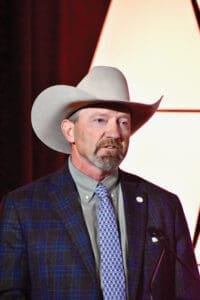By Larry Stalcup Contributing Editor

From antibiotics usage to high-tech disease monitoring, there are animal health-oriented products and services that can help cattle producers prevent or treat sickness at the ranch or the feedyard.
Animal health professionals discussed and exhibited these technologies at the Cattle Industry Convention and NCBA Trade Show earlier this year in Orlando, Fla. They emphasized that producers can develop an animal health plan to improve their production program by working with veterinarians in private practice or who serve as consultants with animal health companies. Here are three animal health tips that could be considered for your operation.
Understanding antibiotics: This complex subject may involve getting a second opinion or two. And the cattle industry has taken the initiative to promote proper antimicrobial usage. Dr. Eric Moore, Norbrook’s North American director of technical service, tells CALF News that the beef industry “has done a phenomenal job” of promoting antibiotics stewardship through the Beef Quality Assurance program.
Antibiotics should not be used to prevent diseases, but to treat sick animals, he says. “Producers don’t want to have to use antibiotics,” but if a disease prevention plan fails, “then we should treat with the right antibiotic, for the right bug, at the right time,” Moore contends.
The beef industry has taken steps to reduce antibiotic usage and answer concerns about antimicrobial resistance in humans. There are systems in place that track different food pathogens, Moore says, and the 2016 Veterinary Feed Directive helped reduce antibiotics usage.
The removal of feed-grade antibiotics also helped reduce the tonnage of antibiotics usage by more than 50 percent, Moore says, adding that, “We have removed anything that is taken for growth promotion.”
Feedlots have intense monitoring systems to assure the judicious use of antibiotics, leading Moore to argue, “There isn’t a safer food supply in the world.
“We couldn’t feed the world if we took away all of the antibiotics. We have put everything under the supervision of the veterinarian. That gives us an oversight that allows us to address that (over-usage).”
Moore says Norbrook offers all five classes of antibiotics for treating sick cattle.
“I don’t think antibiotics are used too often. There is a need for their use on sick animals. It is our duty as stewards of animals to treat them when they get sick,” he says.
“You wouldn’t let your kid suffer if they were sick.”
Prevent Barn Blindness: That refers to cattle handlers, not animals, when it comes to recognizing potential causes and symptoms of Bovine Respiratory Disease (BRD). “Don’t be blind to the cow” when monitoring for BRD, says Dr. Joe Gillespie, professional services veterinarian for Boehringer Ingelheim “Don’t turn a blind eye to opportunities to improve animal health.”
He says BRD management is not as simple as giving a calf a shot and thinking it’s protected for life. “It’s about putting the whole piece together, from herd management, giving the vaccination and making sure we have an effective treatment if vaccination fails. Do we have the tools to overcome respiratory disease?”
Gillespie points out that for a vaccine to be effective, “it must be handled properly, mixed properly and then given properly. We must have a calf that takes it and has a response to it. If those things don’t work together, that one shot will likely not benefit the calf.”
He recommends that producers engage with their veterinarians to better recognize potential blind spots in their cow-calf program. “The vet can help the producer make changes to eliminate them,” he says.
Boehringer Ingelheim has BRD battle plans aimed at building immunity and managing risk through vaccination programs. “We need to reduce stress on the calf, give the vaccine at the appropriate time and to manage any infection,” Gillespie says.
“Not every calf is going to respond. If they do get sick, does the producer have a plan that provides an opportunity to help that calf recover? If we can find those blind spots, we can really make a difference.”
SenseHub at the Feedyard: In 2022, Merck Animal Health introduced the SenseHub technology that uses electronic identification (EID) to measure fed-cattle actions and body temperature. A major goal was to find BRD-infected animals and other sick cattle and get them pulled and treated more quickly. The result has been a $29 per head advantage over relying exclusively on the keen eyes of salty pen riders, says Dr. Jason Nickell, DVM and MAH director of insights and outcomes.
“Cattle are savvy at concealing clinical signs of disease,” he says. “They are much better at doing that than we are at finding them. The premise of SenseHub is finding cattle earlier in the disease phases, and finding cattle that would have been undiagnosed and getting them treated.”
The EID tags capture animal activity and body temperature simultaneously. Using AI, data is analyzed to determine if the symptoms are different than they have been in the past and different from others in the pen.
Gillespie points out that for a vaccine to be effective, “it must be handled properly, mixed properly and then given properly.
Feedyard trial data indicates that the system “is superior to a human pen rider,” Nickell says. “The $29 per head advantages are largely due to the extra animals we can push across the finish line by reducing mortalities and railers. That ultimately means you’re selling more pounds.”
SenseHub trial data was measured for heifers on feed for 60 days at an Oklahoma feedyard, and again at closeout. The 60-day data showed the EID system enabled cattle to be diagnosed with BRD within 14 days on feed, two days earlier than human diagnosis. The mortality rate was 3.1 percent for SenseHub cattle, compared to 4.5 percent.
Data at closeout showed chronics were reduced to 5.6 percent for SenseHub cattle, compared to 8.3 percent for pen-rider detected cattle. Final live weights were 1,057 lb. for SenseHub cattle, 40 lb. more than cattle monitored by traditional pen rider methods.
“There is a large challenge in working against the deeply held paradigm of what we’re used to seeing a sick calf look like,” Nickell says. “We’ve all been trained that a sick calf is depressed and off feed. But we as humans have a hard time seeing those conditions early on. We need to find those (infected) animals earlier.”
Beneficial animal health information, such as these three examples, is typically available from exhibitors at many cattle conferences. Don’t let the opportunities to learn more about how to improve your animal program go to waste.






